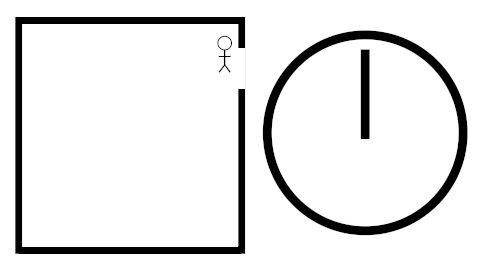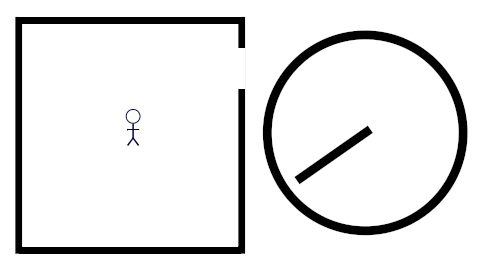Time travel and a walk in the past
TL;DR – Time travel violates physical laws way before you get to the point where you can kill your own grandfather.
A person bumped into me the other day. “Time travel has always fascinated me,” he said. “Is it possible? Could we go back in time and kill Hitler and prevent Nazism? There are so many things I’d like to do!” To which I suggested, “Maybe you could go back in time and avoid running me over with your bike?”
The idea of time travel fascinates many people, especially those with lots of regret. Could we go back? Could we change our past? Would it mean there would be two copies of me? Which is of course nonsense. There are going to be three: you, your original and the other copy that is traveling backwards in time. Most people seem to be forgetting that. Which is kind of the problem.
You see, most people don’t really think about time travel as going back in time. They think of it as disappearing now and reappearing in the past. That’s not “travelling” back in time: that’s “being” back in time. Before you are back in time you have to go backwards in time to reach the time you wanted to go. How do you do that? You may have to plan ahead and set aside a room for you to go back in… there are logistical problems to take into account. And, unfortunately, those may make the whole enterprise rather improbable, as we see in the following disconcerting and farcical thought experiment.
A walk in the past
Suppose you are a physicist and you have invented a time travel machine. One that actually allows you to walk backwards in time. It’s a bracelet, very stylish… I know, you wouldn’t expect it: a physicist with fashion sense. But you are an amazing physicist. Did you know you just invented time travel? Anyway, on the bracelet you have a switch that, once you press it, you reverse the direction of time in which you travel. You are very excited about this. You think of all the prizes you are going to get. All those inventions and discoveries you can now take credit for by submitting papers before the oth…. Hey! Wait a minute! That’s not nice at all!
Anyway, you decide to test it in the following way. You reserve a room all for yourself. You empty it out. You stay outside for a few minutes. You enter the room. You walk along the wall. When you are exactly halfway through, you press your bracelet: you see the clock on the wall ticking backwards. You keep walking forward until you reach the end of the room and then go and stand in the middle of the room. You press your bracelet again. Here’s a super sophisticated animation that shows your walk.

So, the question is: once you stop in the middle of the room and you start going forward in time again, what do you see? Stop and think: it’s a quiz. You are a scientist: you can do it!
Fine, I’ll tell you. As soon as you press your bracelet the second time you see another copy of yourself walking backwards behind you. Once it reaches the end of the wall, the door opens and another copy of you enters and walks along the wall. Both copies walk toward the center of the wall, one backwards and one forward. They crash into each other. They disappear. This is what you see… which is, admittedly, pretty disturbing. For a large number of reasons, too many to list. Here’s another incredibly advanced animation that shows what you’d see.

The main thing that worries you is: where did the mass go? Remember, you are a physicist… that’s the sort of things you worry about. From your perspective, two objects with mass of 200 Kg… Ehm… 70 Kg? How much do you… Whatever, two objects of some unspecified amount of mass were in the room and then disappeared. So, time travel does not conserve mass/energy? That’s unthinkable!
Another perplexing thing is that, while walking, you were flipping a coin over and over, and let it land on your other hand, which was open flat. And you never missed, which is very impressive. Obviously, the copy walking backwards had the coin on the open hand jump up and go on the other hand… the one that flipped it backwards in time. This is kind of a paradox as the laws of physics seem to be working differently for backwards you… Memories are made backwards in time, chemical processes are working backwards in time… So we have two separate set of laws of physics: one for backward and one for forward. But wait: what about the air you were inhaling? If that was forward in time air, and backward in time you breathed it, shouldn’t it have taken oxygen out of you instead of giving you oxygen? That was a very dangerous thing you did there: you could have asphyxiated!
But there is another disturbing thing. You occupy a finite volume. Before the two copies of you disappeared, they occupied the same spot. That means that, at some point, you had to overlap with yourself. Come to think of it, when you entered the room, you saw yourself walking backward. You walked toward yourself. You walked through yourself! Oooww! That’s really messed up! How could you do that? Both in the sense of “how could you occupy the same space of something else?” and “How could you bring yourself to do it?” You may have seen inside your skull…. Bleah…
The more you think about it, the more this didn’t make any sense. How could it have happened? This experience did not make any sense. It’s not something that can happen in the real world. It’s something that can only happen… oooohhh… you were dreaming! What a wonderful and original explanation to resolve the narrative! Hey, nobody paid me to write these things…
The problem with time travel
Most people seem to focus on problems with time travel associated with events that are distant from each other. What if I kill my own grandfather? What if I change history such that I will not be able to go back in time? But the laws of physics don’t work like that: they are relationships between events that are infinitesimally close in time. So, one has to understand how time travel works there first. It’s like when you realize you lost three million dollars at poker. It’s not that you found yourself in that situation suddenly: there were a string of very bad decisions that led you there from when you went out of your house. It doesn’t matter that you could picture a different ending or that you didn’t realize you were making bad decisions at the time. You may want to understand how each moment led you to your miserable end.
The thought experiment shows how problematic the narrative is at any time if, instead of picturing ourselves traveling back in time, we picture seeing ourselves, as a third person, traveling back in time. This is helpful in the poker case as well: it’s much easier for our brain to realize a third person is doing something stupid than to realize we ourselves are doing something stupid. This is actually a defense mechanism that prevents to grasp how truly and utterly incompetent we really are.
The bystander sees two copies of a person compenetrating each other and then annihilating. That’s not something the laws of physics would allow… Actually, wait, this remind of me particle/anti-particle annihilation. So that’s what the bracelet is doing! It’s converting every particle into an anti-particle that travels backward in time! But… hhmmm… then the annihilation should release all the energy, which would probably be enough to destroy earth. Which, admittedly, may be a problematic side effect. Ok, scratch that, that’s a stupid idea. As I was saying, this is not something the laws of physics would allow.
Suppose the bystander increases rapidly the temperature in the room while you are walking backward in time. Do you get warmer according to what the bystander sees, which means you would start feeling colder before you see him changing the temperature? Or do you get colder according to what you see, and the bystander starts to see you getting warmer before he changes the temperature? In both cases, someone is going to have a problem with the laws of thermodynamics.
Presumably, while you travel back in time, you would have to form memories in the exact opposite order. Personally, I would find encountering such person very frustrating. Imagine the dialogue:
A: “Well, bye!”
B: “Sorry who are you?”
A: “My name is also George”
Together: “What a coincidence!!!”
B: “My name is also George”
A: “Sorry who are you?”
B: “Well, bye!”
That’s, of course, impossible! One of them should say “!eyb ,lleW”.
So, you may encounter problems with time travel way before you find yourself in a situation where you could change your own past. But the biggest one, the one that most people struggle with and, quite frankly, frustrates me the most, is incorporating it in science fiction stories without creating plot holes so gigantic that no amount of infinite parallel universes can fill. And, no, a character cursing “I hate temporal mechanics!” does not solve the problem.
2 Replies to “Time travel and a walk in the past”
If we take the view that the paradoxes of time travel are all about conservation of energy, then some insight can be gained by examining that which governs the flow of energy, namely impedance matching. Impedances are of two types – scale dependent (Coulomb, dipole,…) and scale invariant (quantum Hall, centrifugal,…). The scale dependent impedances communicate both amplitude and phase of the wavefunction, the invariant impedances only quantum phase. Phase is relative, not a single measurement observable, and consequentially can travel both forwards and backwards in time. This has been shown experimentally. See for instance https://arxiv.org/pdf/1304.7469v1.pdf. So if you want to incorporate time travel into your scifi story stick with quantum mechanics, let your agent be quantum phase, and don’t frustrate the physicists.
Hi Peter,
Time travel inconsistencies are with thermodynamics, which is not time symmetric. Conservation of energy is just one aspect (i.e. isolated systems conserve energy).